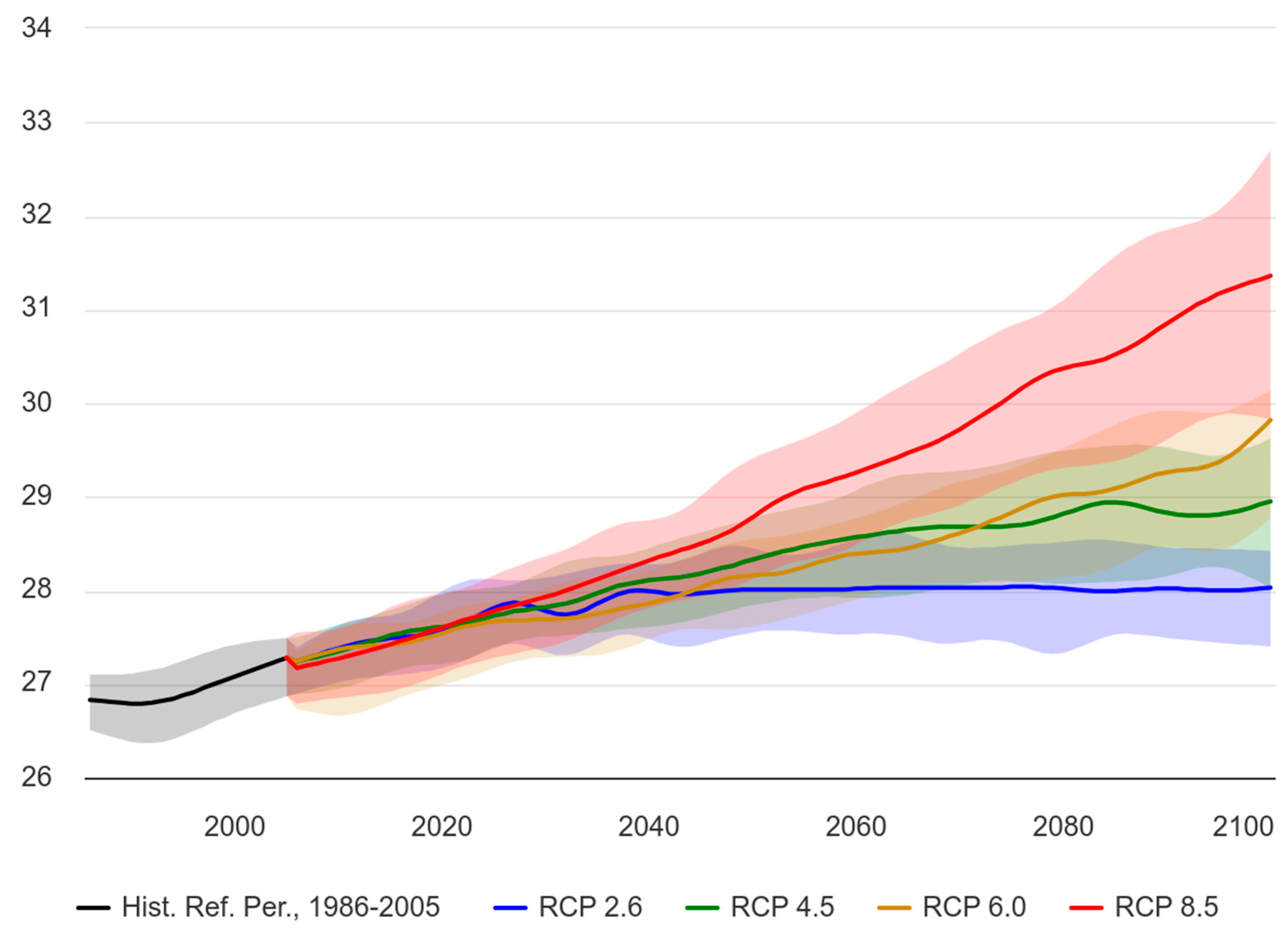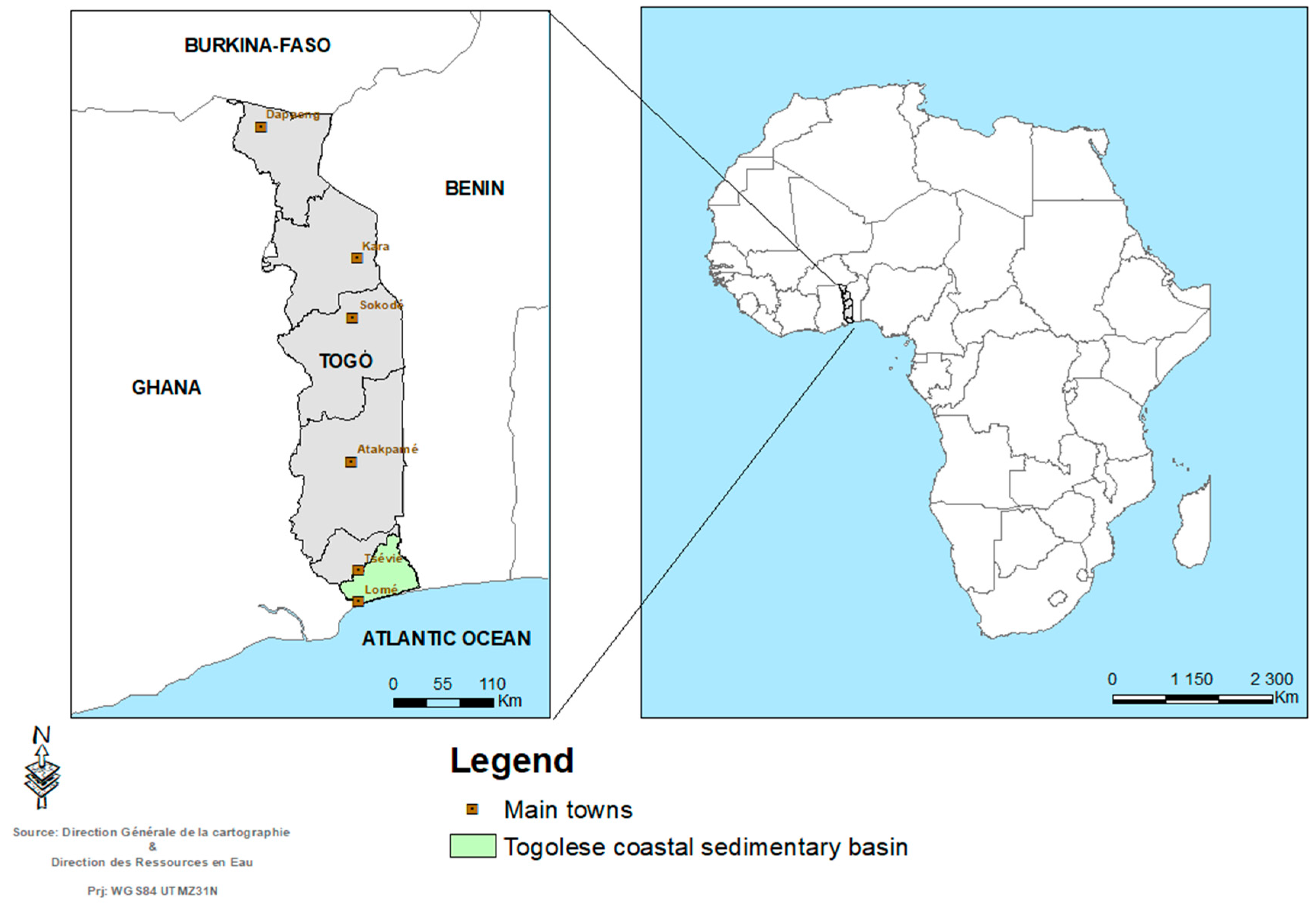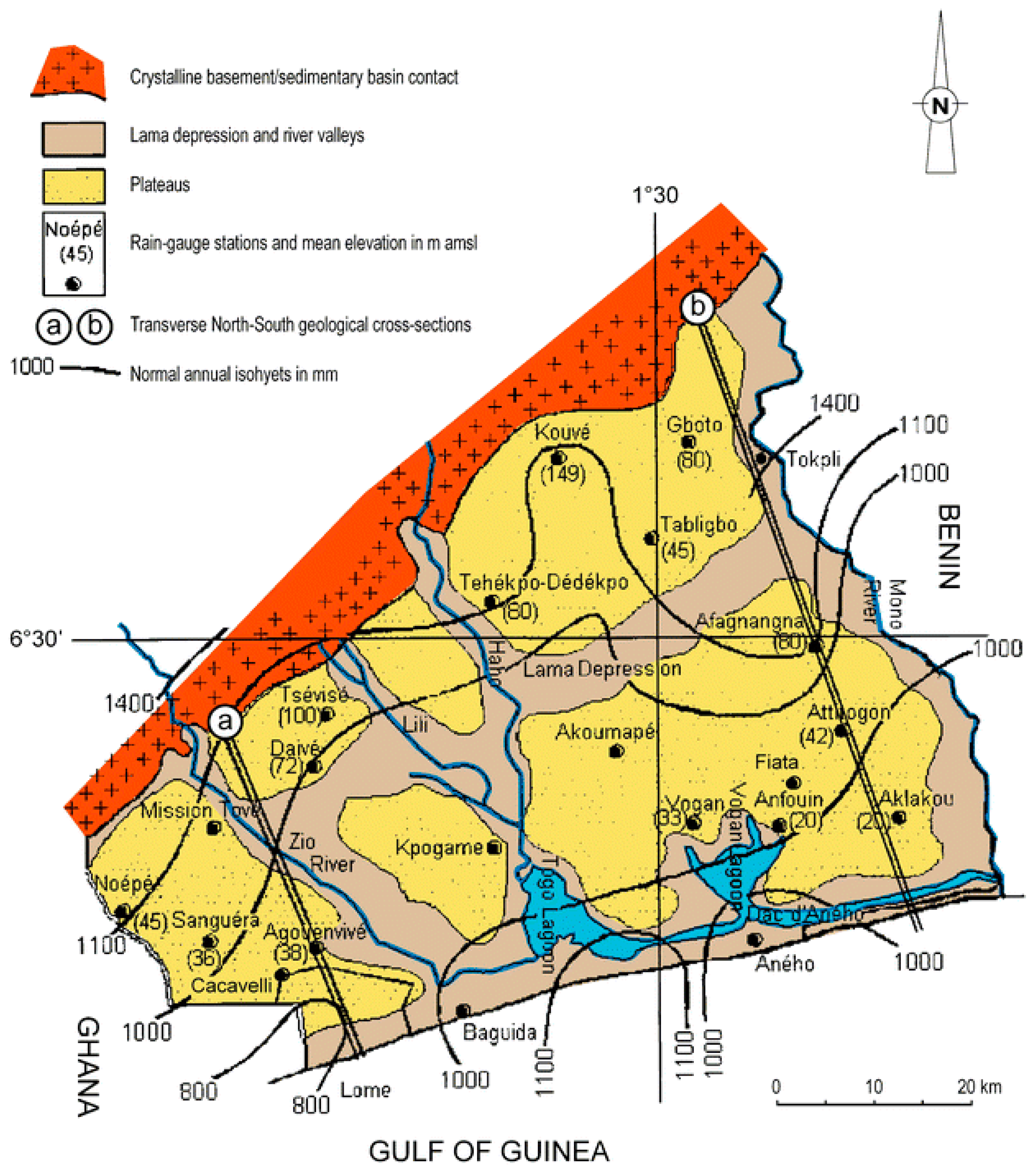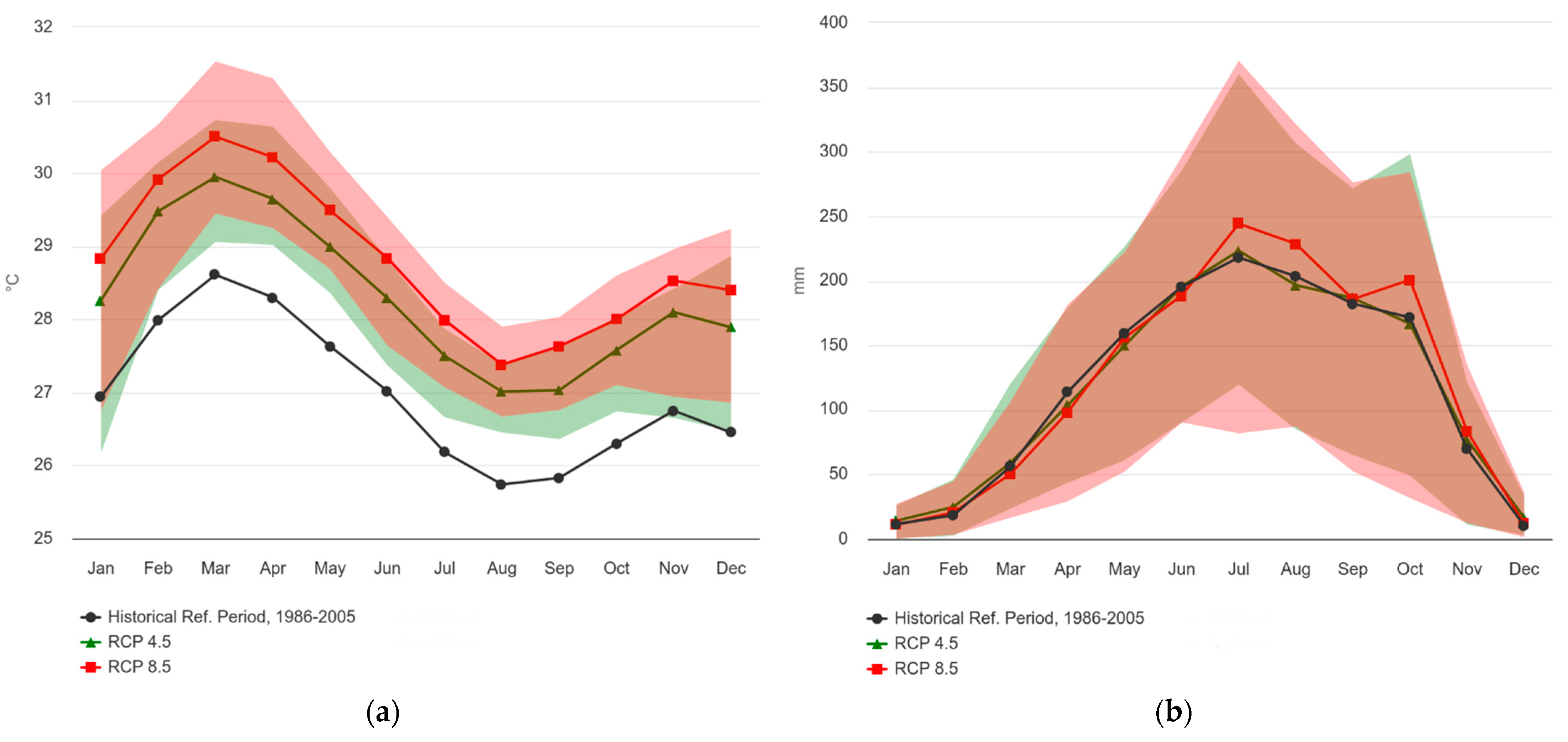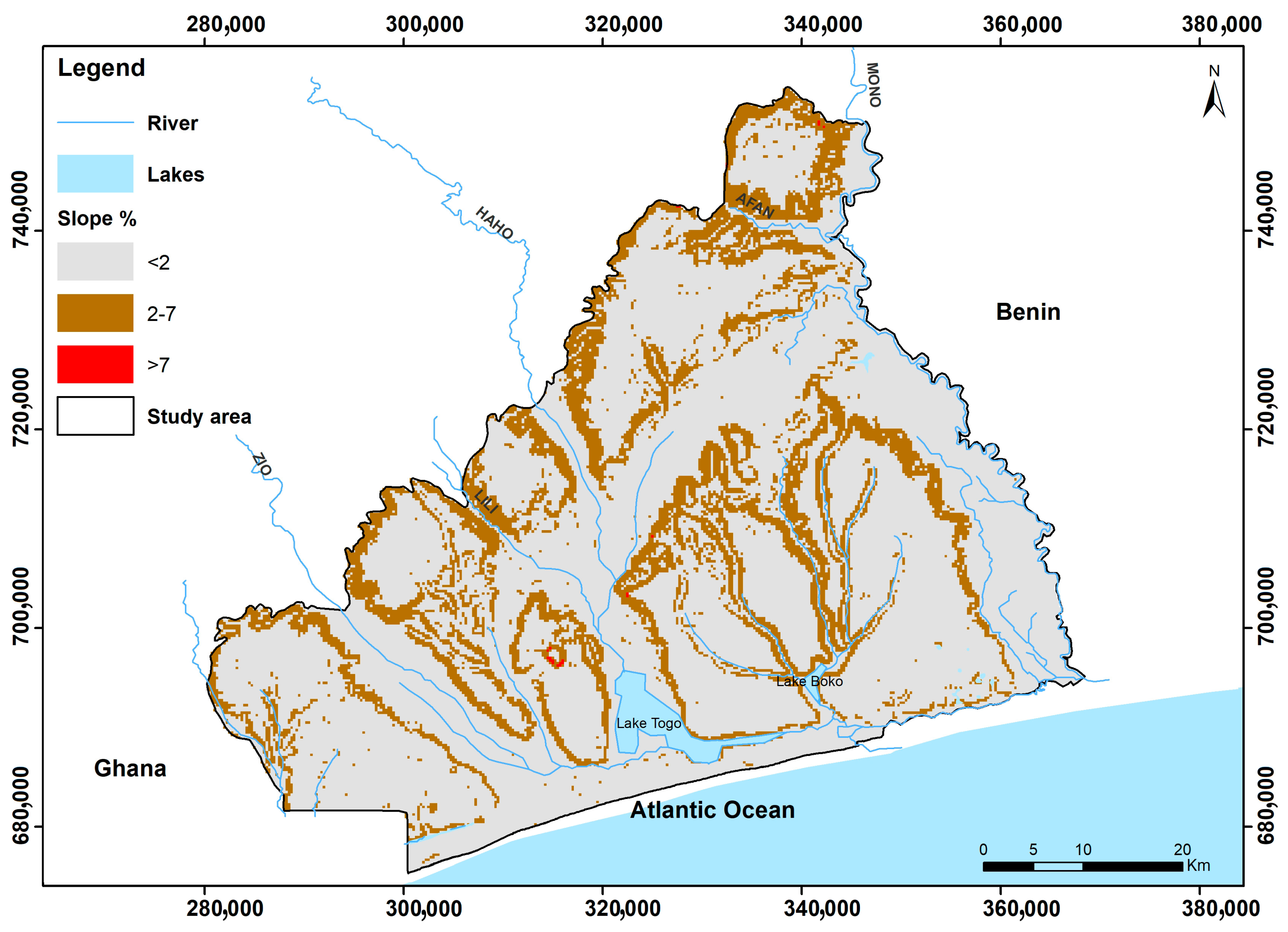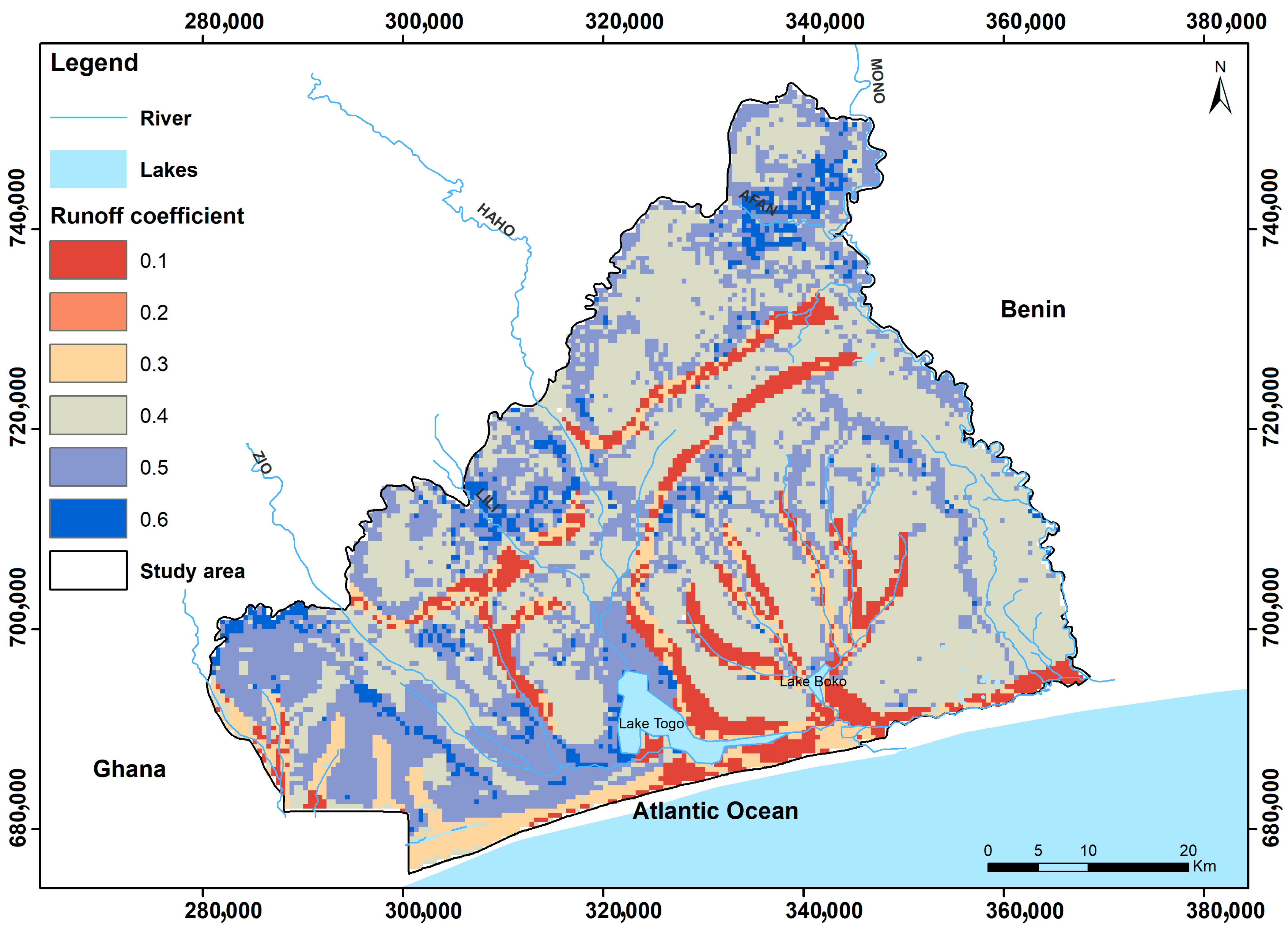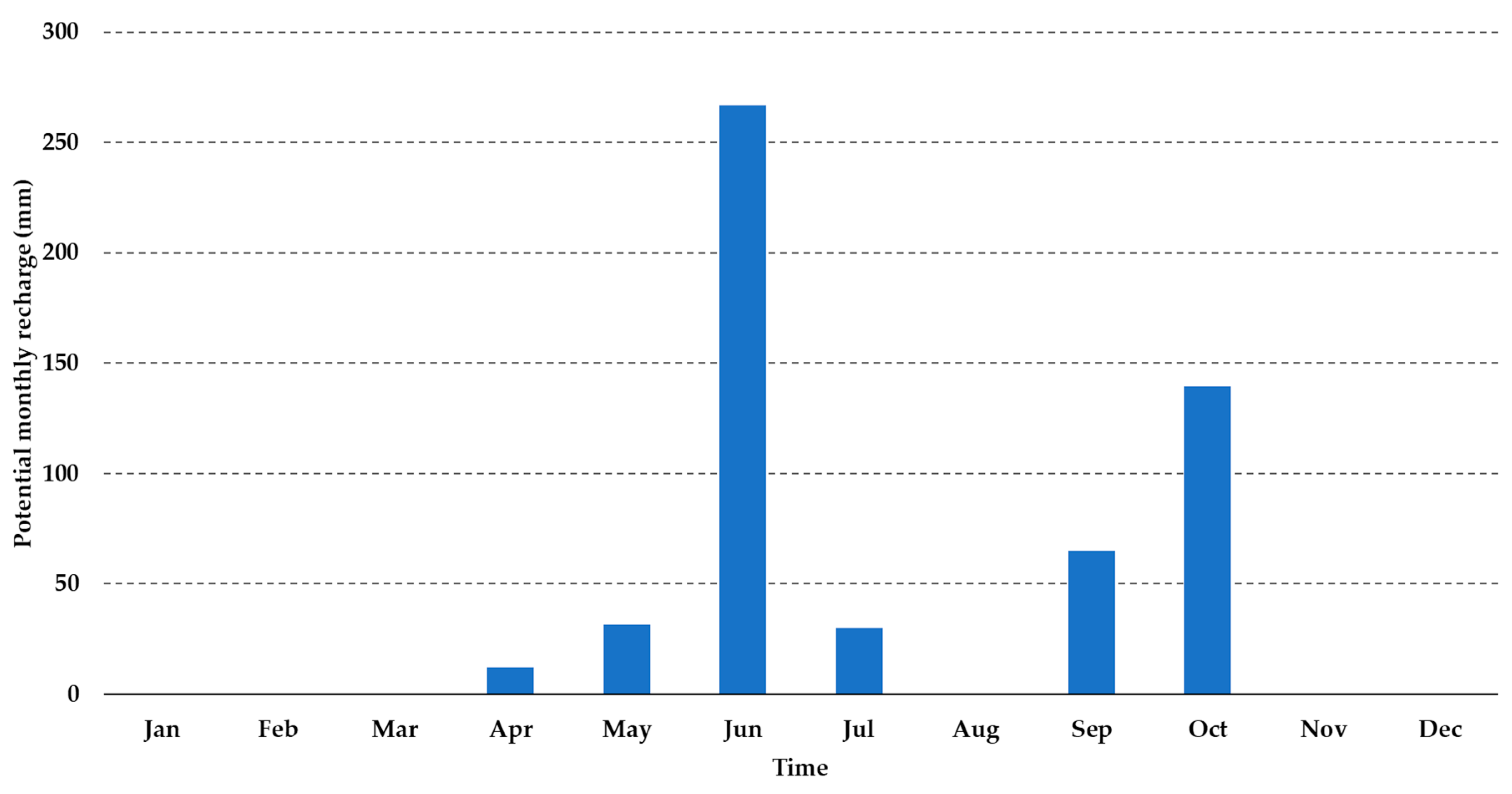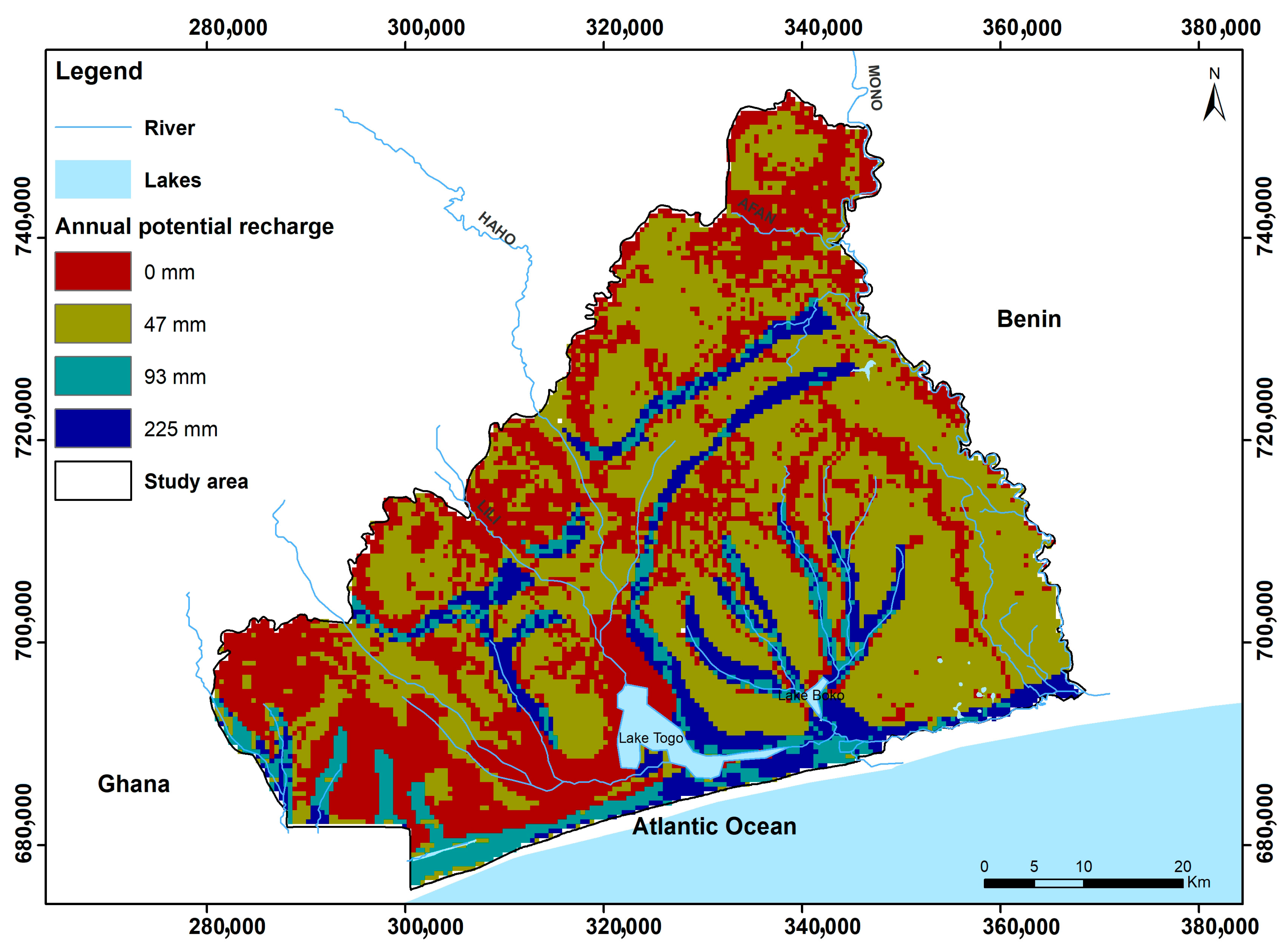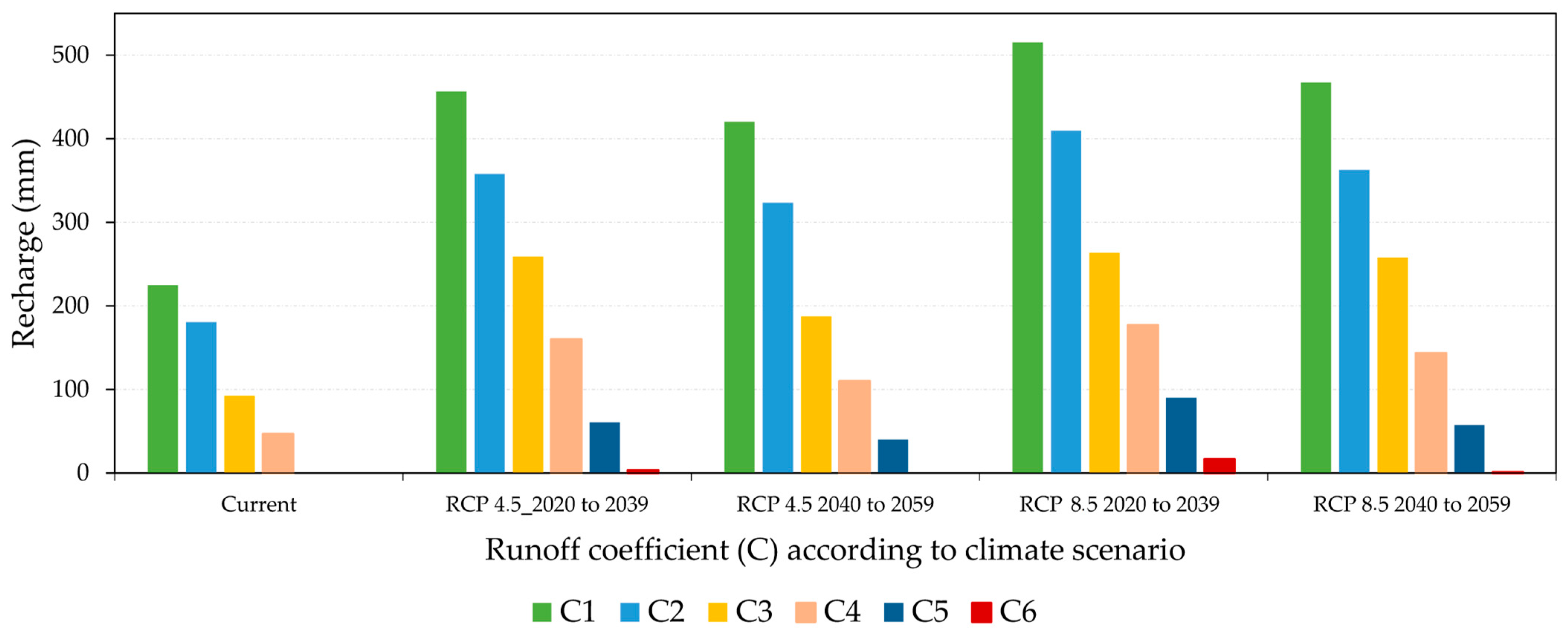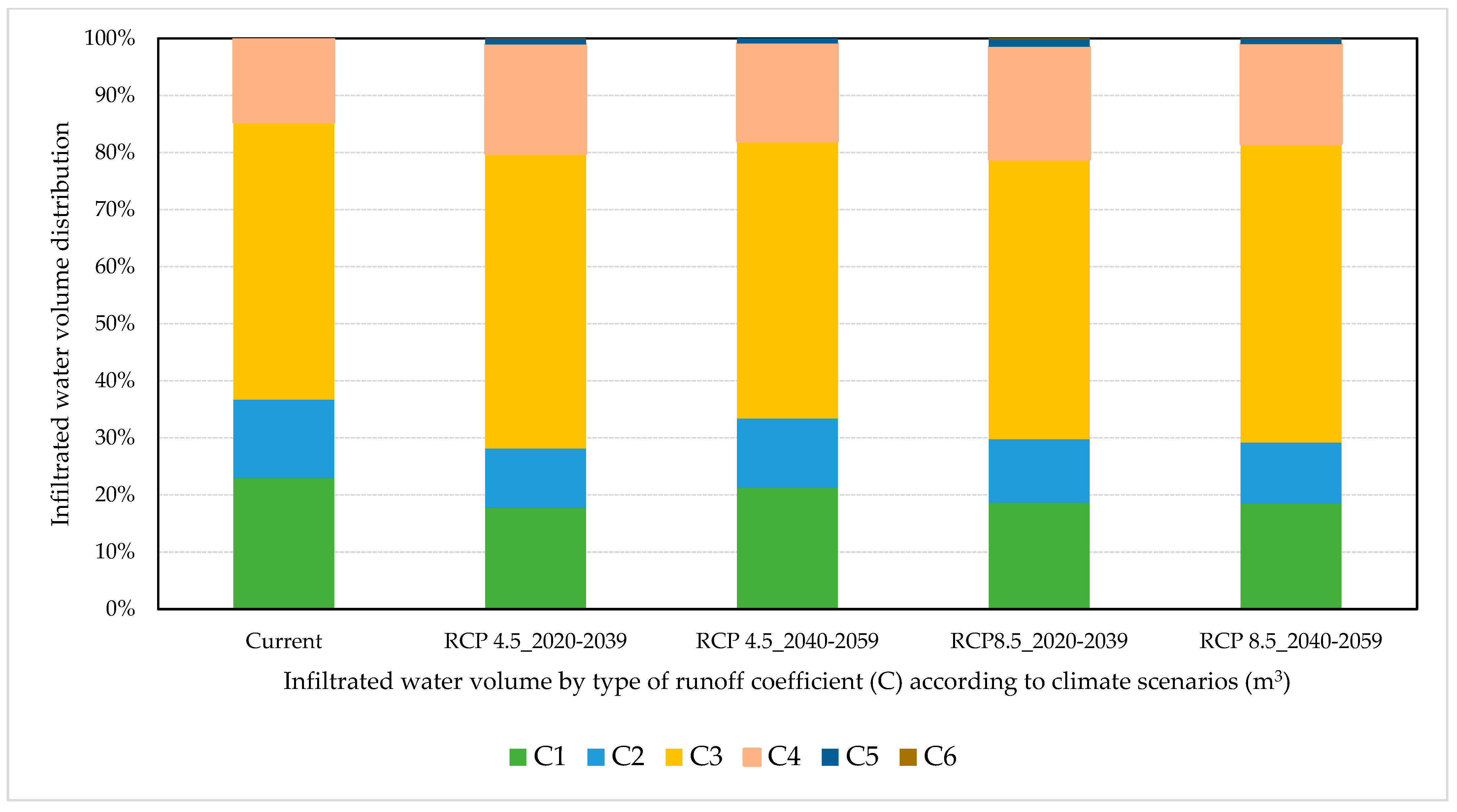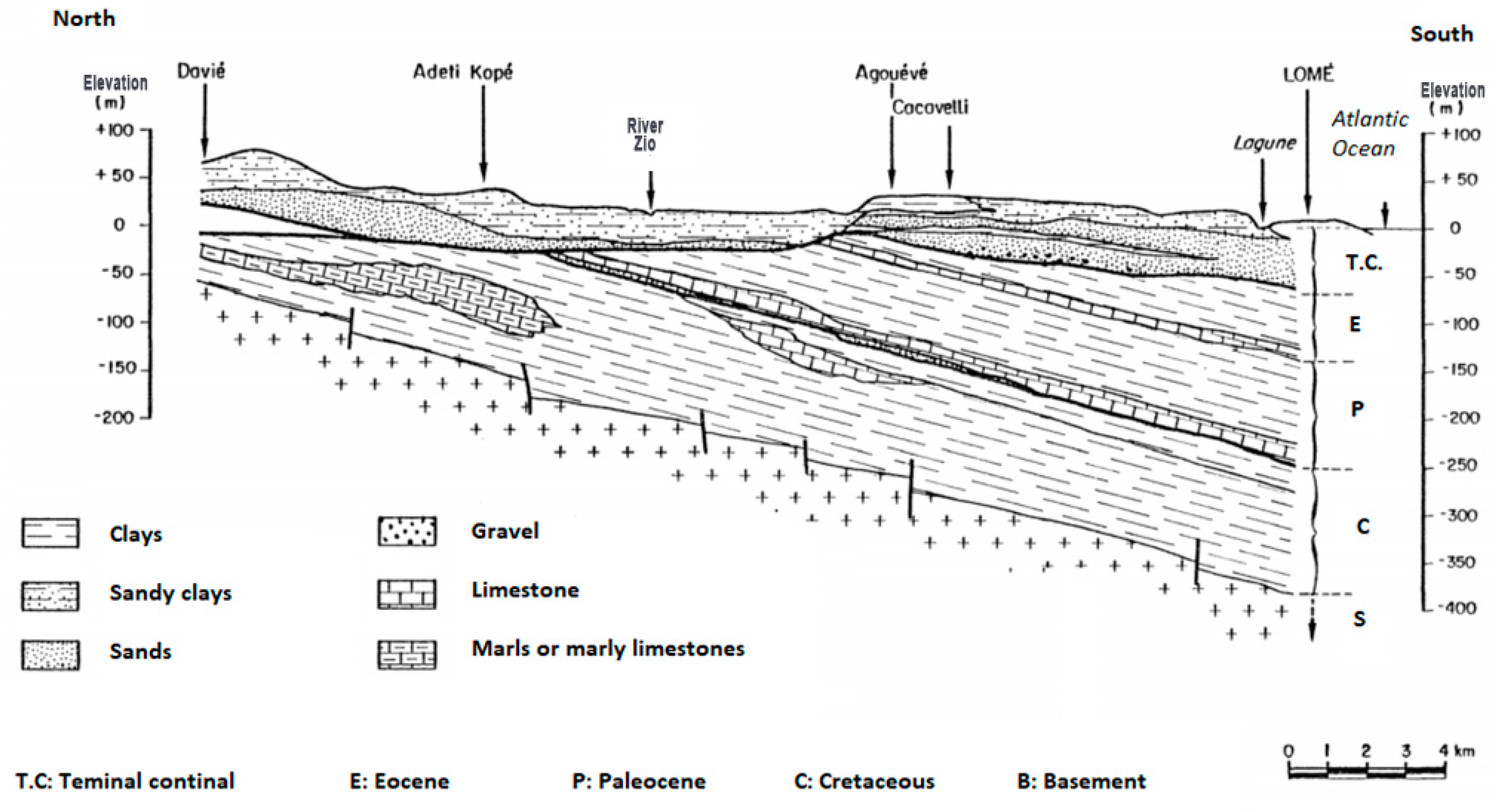1. Introduction
Climate change is real [
1], and it will modify the water cycle [
2,
3]. The hydrological cycle is affected by climatic variations and the interactions between precipitation, temperature, and evapotranspiration [
4,
5,
6,
7,
8,
9,
10,
11]. As a result, each change in the climate system induces a difference in the water system and vice versa [
4], resulting in variations in water availability over time and space. Water excesses or deficits are likely to increase the severity of extreme weather events [
12,
13], including floods and droughts. The risk of deficit is, for its part, accentuated due to the overexploitation of water resources already observed in many regions of the world [
14,
15,
16,
17]. The impacts of climate change also manifest themselves on a social [
18,
19] and economic level, with the weakening of production systems [
20,
21,
22], particularly in agriculture [
23]. They are also illustrated by the increase in drilling costs, the reduction in well yields [
24], and threats to ecosystems [
25,
26]. Finally, also due to climate change, pollution and the degradation of the quality of water resources from anthropogenic activities are accentuated [
4,
27,
28,
29].
This is why climate change is on the political agenda at the national and international levels [
1], and also because regional adaptation strategies rely on water resources [
30,
31,
32,
33,
34]. Assessments of the impacts of climate change on water resources have, therefore, become essential, with those concerning groundwater being even more essential because they represent approximately 98% of global freshwater resources [
4,
35].
Studies on the impacts of climate change on groundwater have multiplied in recent years, and they often focus on the evolution of recharge [
4]. This is because precipitation and temperature determine the availability and movement of water in the environment, which, in turn, influences groundwater recharge rates [
31]. It is then useful for authorities to know about the trends in groundwater recharge over time and space so they can make appropriate arrangements and develop effective water resources management plans [
31,
36,
37,
38].
Recharge is defined herein as the downward flow of water reaching the water table, adding to the groundwater storage [
39]. However, the rate of aquifer recharge is one of the most difficult factors to measure when evaluating groundwater resources [
36] and, by whatever method, is normally subject to many uncertainties and errors [
40]. In fact, groundwater recharge depends on several factors, such as hydraulic conditions and the scale of estimation [
38]. It should also be noted that unmanaged contexts may differ significantly from managed conditions, as recharge may vary depending on system boundary conditions. In addition, the determination of recharge variability in space and time, which is high, creates a number of unresolved problems that require additional investigation [
36].
Groundwater recharge is generally estimated based on monitoring well data and measurements. The most common methods for estimating groundwater recharge are the soil–water balance method, the zero flux plane method, the one-dimensional soil–water flow model, the inverse modeling technique, the groundwater level fluctuation method, the hybrid water fluctuation method, the groundwater balance method, and isotope and solute profile techniques [
40,
41]. However, in many areas of the world [
42], especially in sub-Saharan Africa, spatial and temporal coverage is scarce, and in situ measurements are nonexistent because they are relatively expensive [
43]. Expense is a common limitation when applying some recharge estimation methods [
44]. When considering such challenges, the water-budget method proves to be the most suitable because it is universal and adaptable [
39]. Water budgets are fundamental to the conceptualization of hydrologic systems at all scales [
39]. Building a preliminary water budget from existing data is an easy and logical first step in any study, regardless of whether water-budget methods will subsequently be used to estimate recharge [
39]. It is based on the principle that the water input is equal to the quantity released plus (or minus) the change in the volume of water stored [
45]. The balance can be estimated with semiempirical equations using precipitation and temperature, indirect estimates of evapotranspiration, and runoff [
39,
45,
46,
47]. Using these approaches, it is possible to estimate the recharge rate of a specific aquifer over extended areas, such as at the watershed scale [
45]. Despite the uncertainties inherent in this method, it provides relevant information in terms of the characterization of anthropogenic and climate impacts on groundwater at a low cost and with few resources [
11,
30,
48,
49,
50,
51,
52,
53].
On a global scale, the worst projections related to reductions in recharge were identified for arid and desert areas; the highest recharges were identified in the northern regions and in areas at high altitudes, where recharge capacity is maintained or increases due to rapid snow and glacial melting from temperature increases [
4]. Despite the advances achieved, more studies should be undertaken to analyze groundwater assessment at other latitudes to reach a complete and comprehensive understanding [
4].
In Africa, characterizing the impacts of climate change on groundwater is crucial, due to the fact that more than half of the population depends on groundwater for their needs and economic activities [
54]. In a continent where human and material resources are often limited, groundwater has the advantage of generally being of good quality and abundant [
55]. This interest is also explained by the fact that groundwater has a buffering effect that mitigates the seasonal water availability fluctuations [
56], which is a notable advantage in the face of climate change. However, there are questions, especially about the long-term renewability of groundwater in the African context. These questions are part of a more general reflection on the potential impacts of climate change on groundwater in Africa, in the face of increasing withdrawals, growing pollution, poor monitoring of the resource, and the uncertainties inherent in climate change and modeling [
57].
On the African continent, work must be carried out on a case-by-case basis, due to complex local dynamics. If, in the Sahel and southern Africa, the trend is toward a future decline in recharge [
33,
58,
59,
60,
61], other areas will experience notable increases in recharge, particularly in tropical and equatorial climates [
32], due to climate change.
This study aims to estimate the current and future groundwater recharge in an aquifer system located in the Togolese coastal sedimentary basin in West Africa. This less-monitored aquifer is in an area marked by strong economic and demographic growth. This translates into significant water withdrawals associated with pollution risks, all within the context of climate change. Because of the region’s economic importance, the basin is undergoing rapid urbanization. This has resulted in increased groundwater abstraction, as well as pollution problems caused by inadequate sanitation infrastructure. It is important for decision makers to know how recharge will evolve over time and space, and therefore the future availability of groundwater. This will enable them to make the best choices in terms of decision making.
For this purpose, this study used the simple and robust Thornthwaite and Mather method [
47]. The originality of this study, considering the rarity of the available data, lies in the use of data freely available on the Web (such as current and future local climate data, elevation models, and land-use data). All data were used to identify water balance parameters to support groundwater resource management strategies.
4. Discussion
As described above, the Thornthwaite model was used to estimate current and future recharge under the RCP 4.5 and RCP 8.5 scenarios (for the periods 2020–2039 and 2040–2059) in the Togolese coastal sedimentary basin.
Our results, summarized in
Figure 15, show that, in both scenarios, compared to the current period, groundwater recharge increases more under RCP 8.5 than under RCP 4.5. They also demonstrate that, in the future, recharge will occur in a single block, in contrast to the two peaks of recharge currently observed. This is because the groundwater recharge calculated by the Thornthwaite model is directly dependent on rainfall, and in both scenarios the area in which the basin is located will have only one rainy season, as opposed to the two seasons currently observed.
It is not easy to situate the trends observed in this study within major global trends. It can, however, be noted that the Togolese coastal aquifers are not part of the 44% of global aquifers that will experience recharge difficulties due to climate change [
51]. Indeed, in a recent global review, Cárdenas Castillero, Kuráž, and Rahim Cárdenas Castillero, Kuráž and Rahim [
4] located aquifers that experience decreases in recharge occurring in semi-arid and arid areas, while increases in recharge will be observed in regions where snow predominates in winter and at high altitudes such as the Alps and the Himalayas. Even though the author recognizes that the African continent where the study area is located remains to be studied, a relationship between the recharge and the quantity of water available on the surface in the future may also emerge in Africa. Thus, the regions in which a drop in precipitation is expected—in the Sahel, in North or southern Africa—will experience drops in groundwater recharge [
33,
58,
59,
60,
61]. On the other hand, in equatorial and tropical regions, recharges are expected to increase due to future increases in precipitation [
32,
34].
While climate has a significant impact on groundwater recharge, local physical characteristics also play a role. The runoff coefficient, which reflects the impact of slope, soil permeability, and infiltration capacity, serves as an example. As may be seen from
Figure 16, the recharge is inversely related to the runoff coefficient value. Whatever the climatic scenario, C
1 = 0.1 is found to have the highest recharge. These are regions with very permeable soils, a mild slope (2%), and forest or savannah vegetation. Therefore, these circumstances favor groundwater recharge. The high runoff zones C
6 = 0.6, which are situated on steep slopes (>7%) and where water does not have time to permeate the soil, are at the other end of the spectrum.
Although, in theory, the runoff coefficient determines the recharge in the basin, the surface area covered by each runoff coefficient will also have an absolute impact on the volume of groundwater that actually reaches the aquifer. Since C3 areas (0.3) constitute a larger portion of the basin’s surface area than C1 areas (0.1), it is clear that these areas experience higher recharge volumes (
Table 9 and
Figure 17).
It is also critical to remember that we cannot have blind faith in these outcomes. The anticipated intensity of precipitation may result in more runoff than expected, which will lower the anticipated recharge, given the projected increase in extreme events. Therefore, to produce a more accurate estimate of recharge, information on past, present, and projected changes in rainfall intensity will be required. It is precisely the projected increase in rainfall variability, in both intensity and frequency, that, according to Aizebeokhai [
87], will most likely result in a reduction in recharge in most of southern Nigeria, a region subject to a climate comparable to that of our study area.
Second, changes in land use can also reduce recharge if soils are sealed or increase expected recharge if developments lead to artificial recharge. Favreau et al. [
88] describe an increase in recharge in the Nigerien Sahel due to the type of land use, despite the reduced rainfall observed. On the other hand, even if recharge does occur, it will only supply the unconfined aquifer and the Maastrichtian semi-captive aquifer. The risk of emptying and therefore losing the confined Paleocene aquifer cannot therefore be ruled out.
Finally, a rapid increase in recharge cannot be good news, given that the terminal continental unconfined aquifer is almost outcropping, particularly in the city of Lomé. Groundwater levels could rise significantly in the area, which could cause geotechnical issues and more frequent flooding.
To conclude this section, the results obtained need to be contextualized not as absolute values, but as relative values. Using the methodology adopted, besides considering its own uncertainties related to the water balance, it is necessary to add the many uncertainties related to the climate projections and their scaling [
89]. These results therefore provide directions and trends that must be clarified in the future.
5. Conclusions
In this study, the current groundwater recharge and its future evolution under the RCP 4.5 “optimistic” and RCP 8.4 “pessimistic” climate scenarios were estimated in an ungauged basin in the tropics using the Thornthwaite–Mather balance method. In the context of limited data on groundwater, it was a question of estimating the future evolution of recharge and its distribution in space.
The work was based on current temperature and precipitation data observed in the region between 1991 and 2020 and future climate projections for the periods 2020–2039 and 2040–2059. Evapotranspiration was achieved using the Thornthwaite method, and runoff was estimated based on a coefficient that considers the slope, infiltration capacity, and permeability of the soil.
In today’s climate, annual recharge ranges from 47 to 225 mm. The spatial distribution map of the current recharge obtained from the different runoff classes indicated that recharge in the Togolese coastal sedimentary basin depends almost entirely on the nature of the soil. The highest recharge occurs in the sandy deposits along the shoreline and riverbanks. The lowest recharges are in the sandy loam, especially those marked by urbanization and agriculture. The estimate of future recharge is trending upwards. Under the optimistic RCP 4.5 scenario, recharge will be between 3 and over 455 mm per year from 2020 to 2039 and between 40 and 420 mm per year over the period 2040–2059. Under the pessimistic 8.5 scenario, recharge in the basin will be between 16 and 515 mm per year from 2020 to 2049 and between 1 and 467 mm per year over the period 2040–2059.
This study, which is the first to focus on the issue of recharge in the area, illustrates elements of great importance. First, it shows that the recharge in the basin correlated to precipitation will increase. As a result, from a quantitative standpoint, the risk of water scarcity is low if soil artificialization is controlled and withdrawals are reasonable. On the other hand, the study allowed us to identify the preferential zones of groundwater recharge. This offers the possibility to better target the actions to protect the resource from the risk of pollution, but also to guard against the risks linked to a possible excess of water, such as rising water tables. In the context of limited resources, this is valuable information which will be available to local water resource managers. Indeed, if recharge tends to increase in the future, decision makers can consider directing the limited resources available to preserving water quality to make optimal use of them. However, to determine precise answers, efforts are needed to monitor the resource and to manage land cover and waterproofing, and research is needed to better characterize water balance conditions in time and space, such as evapotranspiration, runoff, and soil moisture.
